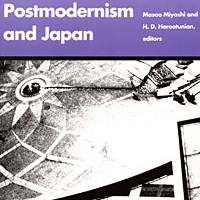"Postmodernism and Japan" opens with editors H.D. Harootunian and Masao Miyoshi declaring that postmodernism is a Western phenomenon that cannot be exported globally. The essays that follow draw connections and expose dissonances between postmodernism and Japan. Topics range from close readings of works of literature to sweeping analyses of technology and culture.
Postmodernism in Japan, Edited by Masao Miyoshi and H.D. Harootunian.
312 pages
Duke University Press, Nonfiction.
Defining terms is a major struggle for the authors, who frequently question the legitimacy of the "postmodern" label. Japanese critic Kojin Karatani claims that elements of Japanese postmodernity can be traced to the early 19th century, while historian J. Victor Koschmann suggests that Japanese modernity "has not fully exhausted its potential." Professor Naoki Sakai stakes out a more radical position, suggesting that postmodernism has "never been dissociated from the geopolitical order of the world" and should be resisted. Other authors sidestep the larger conversation by focusing on individual manifestations of postmodernism.
The contributions of architect Arata Isozaki and novelist Kenzaburo Oe deepen the conversation and are a welcome break in tone. Oe's clear writing cuts through academic vagaries to express the pessimism that pervades most of the essays.
"Postmodernism and Japan" is a cacophony of opinions, but the contradictions and congruences amount to a coherent conversation. It is a multifaceted introduction to criticism on contemporary Japan.
Read archived reviews of Japanese classics at jtimes.jp/essential.



